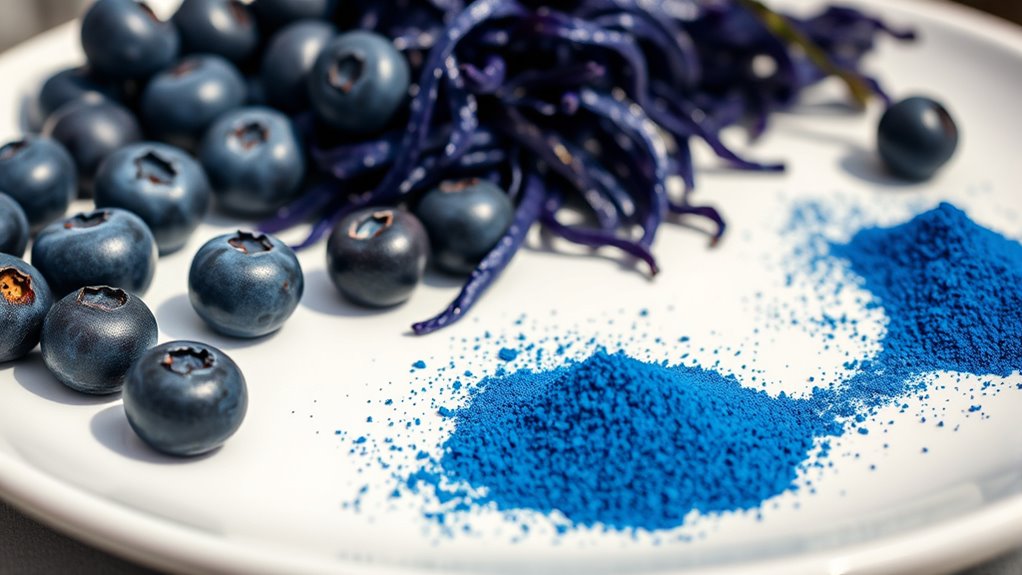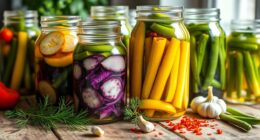Yes, blue foods from the ocean are poised to become the next superfood wave. They’re packed with essential nutrients like omega-3s, iodine, and vitamins, supporting your brain, immune system, and heart. Ocean farming guarantees these foods are sustainable, eco-friendly, and rich in flavor. As more people embrace these options, you’ll discover innovative ways to include blue foods in your diet. Keep exploring to see how they can benefit both your health and the planet.
Key Takeaways
- Blue foods are nutrient-dense, rich in omega-3s, iodine, and vitamins, supporting overall health and wellness.
- Ocean farming sustainably cultivates blue foods, reducing environmental impact and promoting biodiversity.
- Their natural growth preserves flavor and nutritional integrity, making them highly bioavailable and beneficial.
- Incorporating blue foods into diets is easy through recipes like salads, soups, and seafood dishes.
- Growing awareness and advancements in ocean farming position blue foods as a promising superfood wave for the future.

As interest in sustainable and nutrient-rich foods grows, blue foods are emerging as a promising superfood for the future. These foods, harvested from the ocean, offer a unique combination of health benefits and eco-friendly practices, making them an attractive option for health-conscious consumers. Ocean farming, a method of cultivating seafood and seaweed directly in their natural habitats, plays an essential role in revealing the full potential of blue foods. Unlike traditional agriculture, ocean farming minimizes land use, reduces carbon emissions, and promotes biodiversity. By harnessing these sustainable practices, you can enjoy nutrient-dense foods that are both good for your health and gentle on the planet.
Blue foods from ocean farming offer sustainable, nutrient-rich benefits for a healthier planet and you.
One of the key reasons blue foods are gaining attention is their impressive nutritional benefits. Many blue foods, such as seaweed, shellfish, and certain fish, are packed with essential nutrients like omega-3 fatty acids, iodine, magnesium, and vitamins A, D, and B12. These nutrients support brain health, boost immune function, and promote cardiovascular wellness. For example, omega-3 fatty acids found in blue fish can reduce inflammation and improve your mood, while iodine-rich seaweed helps regulate your thyroid function. Unlike land-based superfoods, blue foods often contain a broader spectrum of nutrients naturally integrated into their structure, making them highly bioavailable for your body.
Ocean farming further amplifies these benefits by ensuring a steady, sustainable supply of high-quality blue foods. Since these foods are cultivated in their native environments, they grow naturally, free from the contaminants often found in farmed land-based produce. This natural growth process preserves their nutritional integrity and flavor profiles. Additionally, ocean farming encourages biodiversity and helps restore marine ecosystems, which can be disrupted by overfishing and industrial pollution. This sustainable approach means you can incorporate blue foods into your diet with confidence, knowing you’re supporting environmentally responsible practices. Sustainable farming techniques in ocean cultivation also help preserve the health of our oceans for future generations.
Incorporating blue foods into your diet doesn’t require drastic changes. You can add seaweed to salads, soups, or smoothies for an extra nutrient boost. Shellfish like oysters and mussels can be enjoyed grilled or steamed, providing a delicious way to get your omega-3s and zinc. Fish such as salmon or sardines are versatile and easy to prepare, offering a convenient source of healthy fats. As awareness of their benefits spreads, more innovative products and recipes are emerging, making it easier for you to embrace blue foods as a superfood option. With ongoing advancements in ocean farming, the promise of blue foods as a sustainable, nutrient-rich superfood wave becomes increasingly clear, offering a future where health and environmental responsibility go hand in hand.
Frequently Asked Questions
What Exactly Qualifies as “Blue Food”?
When you ask what qualifies as “blue food,” it usually refers to foods with a distinct blue hue, often linked to color symbolism of calm and trust. These foods can be natural, like blueberries, or genetically modified to enhance their color. The genetic modification process allows for more vibrant shades, but it also raises questions about safety and authenticity. Blue foods stand out, making them appealing for health and marketing reasons.
How Sustainable Is Blue Food Cultivation?
You might wonder how sustainable blue food cultivation is. Marine farming, when managed responsibly, can reduce environmental impact by utilizing less land and freshwater compared to terrestrial farming. However, it also risks pollution and habitat disruption if not carefully regulated. Overall, sustainable practices in marine farming can make blue food a more eco-friendly option, but ongoing efforts are vital to minimize environmental impact and ensure long-term viability.
Are Blue Foods Suitable for All Diets?
You might wonder if blue foods suit all diets. While they often have unique flavor profiles and cultural significance, they aren’t suitable for everyone, especially those with allergies or specific dietary restrictions. Blue foods can add vibrant variety and nutritional benefits, but it’s crucial to take into account individual needs and preferences. Incorporating them thoughtfully ensures you enjoy their cultural richness and flavor without compromising your dietary requirements.
What Are the Potential Health Benefits of Blue Food?
Blue food offers impressive health benefits thanks to its rich nutritional content and antioxidant properties. When you include blue foods in your diet, you may boost your immune system, improve eye health, and reduce inflammation. These foods contain compounds like anthocyanins that help fight free radicals. Incorporating blue foods can enhance your overall well-being, making them a beneficial addition to a balanced diet focused on health and longevity.
How Does Blue Food Compare Cost-Wise to Other Superfoods?
Imagine discovering a superfood that might revolutionize your diet—blue food. When it comes to blue food affordability, it’s still emerging, making its cost comparison to other superfoods uncertain. You might find it pricier initially, but as demand grows and production scales up, prices could drop. Keep an eye on this vibrant trend; its affordability could soon match more established superfoods, turning blue food into a budget-friendly super option.
Conclusion
Imagine a plate vibrant with shades of blue, each bite offering more than just stunning color—it’s a glimpse into the future of superfoods. Could blue foods reveal new health benefits and transform your diet? As scientists uncover their secrets, the next superfood wave might be just around the corner. Are you ready to embrace this colorful revolution and see what blue foods can do for you? The future is waiting, and it’s beautifully blue.









